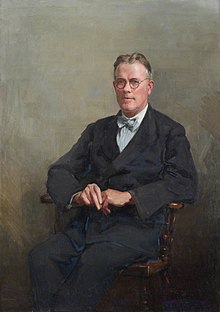Our website is made possible by displaying online advertisements to our visitors.
Please consider supporting us by disabling your ad blocker.
Charles Inglis (engineer)
Charles Inglis | |
|---|---|
 1926 portrait by Douglas Gordon Shields | |
| Born | Charles Edward Inglis 31 July 1875 Worcester, Worcestershire, England |
| Died | 19 April 1952 (aged 76) |
| Education | Cheltenham College King's College, Cambridge |
| Occupation | Engineer |
| Spouse | Eleanor Moffatt |
| Children | Two daughters |
| Parent(s) | Dr. Alexander Inglis Florence Feeney Inglis |
| Engineering career | |
| Discipline | Civil, Mechanical, Structural |
| Institutions | Institution of Civil Engineers (president), Institution of Mechanical Engineers (honorary member), Institution of Naval Architects (council member), Institution of Structural Engineers (council member), Institution of Waterworks Engineers (council member), Royal Society (fellow) |
| Significant design | Inglis Bridge |
| Awards | Telford Medal Charles Parsons medal Fellow of the Royal Society |
Sir Charles Edward Inglis (/ˈɪŋɡəlz/;[1] 31 July 1875 – 19 April 1952) was a British civil engineer. The son of a medical doctor, he was educated at Cheltenham College and won a scholarship to King's College, Cambridge, where he would later forge a career as an academic. Inglis spent a two-year period with the engineering firm run by John Wolfe-Barry before he returned to King's College as a lecturer. Working with Professors James Alfred Ewing and Bertram Hopkinson, he made several important studies into the effects of vibration on structures and defects on the strength of plate steel.
Inglis served in the Royal Engineers during the First World War and invented the Inglis Bridge, a reusable steel bridging system – the precursor to the more famous Bailey bridge of the Second World War. In 1916 he was placed in charge of bridge design and supply at the War Office and, with Giffard Le Quesne Martel, pioneered the use of temporary bridges with tanks. Inglis retired from military service in 1919 and was appointed an Officer of the Order of the British Empire. He returned to Cambridge University after the war as a professor and head of the Engineering Department. Under his leadership, the department became the largest in the university and one of the best regarded engineering schools in the world. Inglis retired from the department in 1943.
Inglis was associated with the Institution of Naval Architects, Institution of Civil Engineers, Institution of Mechanical Engineers, Institution of Structural Engineers, Institution of Waterworks Engineers and British Waterworks Association; he sat on several of their councils and was elected the Institution of Civil Engineers' president for the 1941–42 session. He was also a fellow of the Royal Society. Inglis sat on the board of inquiry investigating the loss of the airship R101 and was chair of a Ministry of War Transport railway modernisation committee in 1946. Knighted in 1945, he spent his later years developing his theories on the education of engineers and wrote a textbook on applied mechanics. He has been described as the greatest teacher of engineering of his time and has a building named in his honour at Cambridge University.
- ^ "Inglis Bridge, Aldershot". Basingstoke Canal News. Vol. 190. 2001. Archived from the original on 25 September 2008.
Previous Page Next Page


